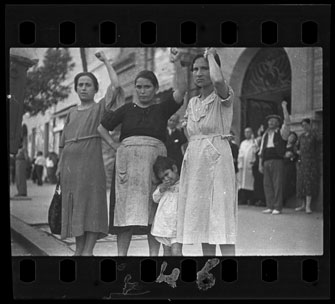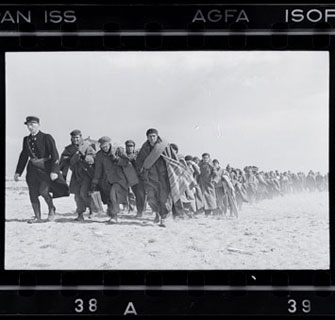History in a Suitcase
Rediscovered in Mexico

”Spectators Watching the Funeral Procession of General Lukacs, Valencia, June 16, 1937,” by Gerda Taro. © International Center of Photography
There are moments in history when the loss of a suitcase does not constitute an easily remedied oversight, but a genuine tragedy, a wound to society’s collective memory. One of the most moving examples is – or was until its triumphant recovery – the fabled lost “Mexican suitcase” full of rolls of film of the Spanish Civil War (1936-9) taken by the photojournalists Robert Capa, Gerda Taro and David (“Chim”) Seymour. Their documentation of the anti-fascist movement swiftly made them rare star photographers whose methods were copied again and again by subsequent conflict journalists, as well as by amateur camera-users inspired and humbled by the sacrifices they undertook to capture the right picture.
The suitcase was believed to have gone missing in 1939 in Paris and to contain unseen pictures of the war in Spain. Following a search of nearly seven decades, it surfaced in Mexico six years ago, whereupon hopes about its contents were proved to be right, even a shade conservative. To celebrate the discovery and show the negatives to a public too long deprived, an exhibition was put together by the International Center of Photography de New York and is now on show at Paris’s Musee d’Art et d’Histoire du Judaïsme.
Things have changed enormously since Taro, Chim and Capa were working. Photography is now ubiquitous, as common in a warzone as it is in a restaurant. Yet for all the time that has elapsed since the trio’s images were captured, they remain stirring, aesthetically sophisticated and entirely unique, both as historical artifacts and as artworks. Mostly consisting of depictions of open warfare, with its barricades, trenches and evacuations, the photographs shed light on a period that is all too often overlooked in favor of the more dramatic world war that started just after it ended. They also present a fresh perspective on three great photographers – and three great friends – who would inspire photographers long after they had put down their cameras for good.
The contact sheets are displayed among blown-up photographs taken by the trio, many of which are instantly recognizable – including David Chim’s famous “Extremadura,” which still packs a punch, showing a mother breast-feeding a baby while listening to a political speech. Magazines, reviews and letters pepper the exhibition, helping visitors enter the spirit of the age. Also interesting are the notebooks used by the threesome to keep track of their published work: these yellowing pages, scribbled over in pencil, forge a tangible connection between the trio’s public faces

“Republican Exiles Being Taken to an Internment Camp, Le Barcarès, 1939,” by Robert Capa. © International Center of Photography/Magnum Photos
as intrepid documenters of the Spanish Civil War and their lesser-known identities as hard-working, brave and committed soldiers, determined to expose the horrifying realities they were both witnesses to and victims of – Taro was killed in an accident in 1937 while covering the war.
For all the show’s success, however, its execution is by no means perfect. Many of the images on the contact sheets are so small that relating to them – indeed seeing them – can be difficult, especially at peak times when the space is crammed with peering punters. More information about the Spanish Civil War would have been welcome too – contextualizing the activities depicted in the photographs can be a struggle, not least because of the multitude of different rooms and levels on which the exhibition is laid out.
Despite its drawbacks, “La Valise Mexicaine” is an impressive and important exhibition, whose success is finally less due to the photographs themselves or to the philosophy underpinning them than to the captivating narrative behind their disappearance and recovery.
Musee d’Art et d’Histoire du Judaisme: Hôtel de Saint-Aignan, 71, rue du Temple 75003 Paris. Métro: Rambuteau or Hotel de Ville. Open Monday-Friday 11am-6pm (until 9pm on Wednesday); Sunday, 10am-6pm. Admission: €7 Through June 30. www.mahj.org
Reader reaction: Click here to respond to this article (your response may be published on this page and is subject to editing).
Please support Paris Update by ordering books from Paris Update’s Amazon store at no extra cost. Click on your preferred Amazon location: U.K., France, U.S.
More reviews of Paris art shows.
© 2013 Paris Update
Favorite